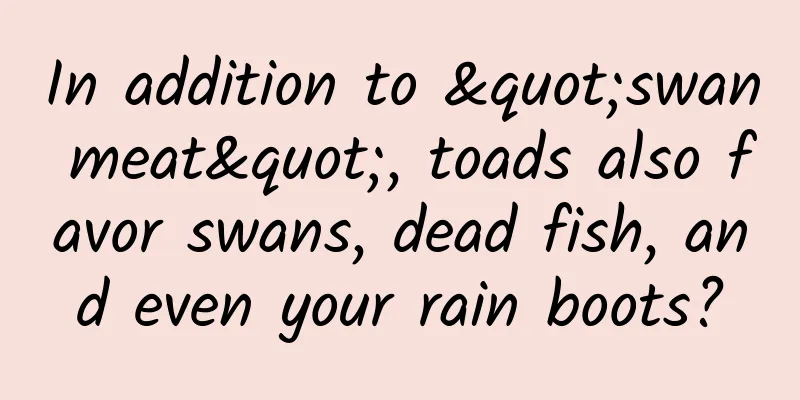In addition to "swan meat", toads also favor swans, dead fish, and even your rain boots?

|
There is a saying that goes "A toad wants to eat swan flesh." In fact, a toad may not only favor swans, but also dead fish or even your rain boots. A giant toad (Bufo bufo) trying to mate with a dead fish | Kerstin Hinze / naturepl.com In recent years, more and more people have recorded frogs trying to mate with the wrong partners . It is not clear why this is happening, but this wrong kind of love may be pushing frogs into an evolutionary trap. The beginning of love Frogs and toads, as we commonly call them, can be collectively referred to as frogs, that is, tailless amphibians. Because of the high permeability of the skin, it is easy to lose water, and the tadpole period needs to live in water, so frogs cannot completely leave the water for reproduction, and the breeding season of most frogs is concentrated in the rainy season . With the arrival of the rainy season, male frogs will occupy suitable breeding sites and then start singing; female frogs will follow the guidance of frog calls to find their ideal lover. When a pair of lovers who are in love meet, under the induction of hormones, they begin to hug each other . The Chinese tree frog (Hyla annectans) under the light is good for eating and hugging|脄_兰 The most common breeding behavior of frogs is to hold the female with the male's forelimbs. Different frog species hold the female with different positions and tightness during mating. Some hold the female by the head, some by the throat, some by the back, and some by the head. There are eight types of holding. Illustration of frog pairing patterns|Carvajal-Castro et al., 2020; Chinese translation: 芄_兰 Among the many different modes of holding, the inguinal mode is considered to be the most primitive. This mode of holding is relatively weak, the cloacae (the passage for excrement, urine, farts and reproductive cells) of the male and female individuals are relatively far apart, and the efficiency of sperm and egg combination is not high. Ancient groups such as the tailed toad and the negative toad all adopt this mode of holding. African dwarf frogs (Hymenochirus boettgeri) in groin-hugging pairs | Quatermass / Wikimedia Commons Under the influence of multiple factors such as physiology, behavior and ecology, frogs have gradually evolved other types of embracing, among which the armpit position is the most common, adopted by nearly 80% of frogs. Male frogs who adopt this popular position will hold the shoulders or armpits of the female frog tightly, because there is a suitable fulcrum, this hold is relatively firm, and the female frog's freedom of movement is guaranteed as much as possible. This popular posture emerged mainly because successful cuddling does not mean successful reproduction. When the breeding ground is limited and the population is large, a large number of frogs gather in a narrow space, and some single male frogs who have not found a partner will harass their peers who are cuddling, trying to drive off the competitors on the female frogs. Therefore, male frogs that are strong and hold firmly are more likely to successfully become fathers. Axillary pairs can adapt to different microhabitats: A. Atelopus favescens; B. Centrolene savagei; C. Ceratophrys calcarata; D. Dendropsophus triangulum; E. Engystomops pustulosus; F. Agalychnys callidryas; G. Pristimantis orpacobates; H. Lithobates vaillanti | Carvajal-Castro et al., 2020 In addition, there are a few groups that do not mate in pairs, and are collectively classified as "non-pairing". Regardless of whether they mate in pairs or not, female and male frogs will use various body positions to bring their cloacae as close as possible, and then discharge eggs and sperm respectively. When sperm and eggs meet in the water or in the follicle to form a fertilized egg, a new life is conceived. Compared with the "Buddhist" non-pairing, male frogs that adopt pairing behavior can increase the fertilization rate of eggs and ensure that " my baby's father is me ". Getting on the Wrong Sedan Before pairing up, frogs use a variety of methods to identify species, including acoustic and visual cues. However, during the breeding season, some frogs will indiscriminately grasp anything that resembles a female frog , such as a corpse, a different species of frog, another organism, or even a non-organic object—a behavior that is technically described as " false pairing ." At present, mismatching has been recorded in more than 150 species of frogs , with the most records in Ranidae, Toadidae and Hylae. Mismatching is most typical in Toadidae. Frogs in Toadidae, such as Chinese Toad and Giant Toad, are often recorded to be mating with corpses, foreign frogs, lizards, dead fish, branches, and even plastic cups, rain boots and other objects. During a field survey, when I was shooting the "precious" picture of Ailao River Toad and Yunnan Spiny Frog mating, my companion brought a river toad that was mating with his finger. I heard that when he was catching the river toad for observation, the male toad took the opportunity to mating with his finger... These love beyond species that will never have a result is really touching (bushi). Yunnan spiny frog (Nanorana yunnanensis) and Ailao stream toad (Bufo ailaoanus) hugging fingers|芄_兰 It is said that the breeding season of the Ailao River frog is only around the beginning of summer heat, and during the breeding period, there will be a scene of "tens of thousands of frogs hugging each other". The short breeding season may be the reason for the frequent occurrence of wrong pairs. For species with a short breeding period or very scarce females , single male frogs should be "shameless" in order to pass on their genetic material, and strive for all possible breeding opportunities with the attitude of " I would rather make a hundred mistakes than miss one ". Moreover, surprisingly, in very rare cases, wrong pairs can also produce good results. For example, cuddling with a corpse may cause the corpse to expel active eggs, and hybridization with closely related species also has a very small probability of producing offspring. A large ghost marriage scene, a small frog in the Amazon region (Rhinella proboscidea) will induce the dead female to release eggs and fertilize them|Izzo et al., 2012 But this was more than just a mismatch. But mistakes are mistakes, and when there are too many of them, the frogs get into trouble. Biological reproduction requires a high energy cost. Failure to accurately find a mate means a lower success rate of reproduction and an increase in the cost of reproduction . This will lead to serious consequences, such as a decline in the number of the entire population. Moreover, when embracing with the same sex or the opposite sex, the wrongly embraced object can still give feedback or break free through body or sound after noticing the problem; however, if it is embracing with a corpse or non-organic matter, the initiator of the embrace will not receive any information feedback and will not give up voluntarily. If it continues to cling to a stationary corpse or non-organic matter, it will expose itself to danger for a long time , which can easily be discovered by predators - not only will it fail to leave offspring, but it may even lose its life. In addition, extreme weather has occurred frequently in recent years, and these unpredictable climates have made frog reproduction even more difficult, forcing frogs to seize any possible opportunities in the short breeding season. A study showed that in Italy, climate change has caused the breeding grounds and breeding time of the big toad and the green toad to overlap more and more, leading to an increase in mismatches between the two species - they may hybridize with different species of toads, and most of the tadpoles produced are severely deformed. Mismatched mating and hybridization between Bufo bufo and Bufotes balearicu, resulting in deformed tadpoles | Canestrelli et al., 2017 What's worse is that with the development of human society, the habitats that frogs rely on for survival have gradually become fragmented, and finding mates has become increasingly difficult in many cases . In addition, although frogs have very efficient visual recognition capabilities, they are still unable to cope with man-made objects of different colors, shapes and sizes. They may mistake plastic cups, tennis balls and other products that fall into their territory as mating objects and cuddle with these non-living objects. For species with already small populations or short breeding seasons, this evolutionary trap affects their normal reproduction, causing the population size to continue to shrink; which in turn makes it even more difficult for them to find mates - this puts these frogs in a vicious cycle . Although it is not yet clear whether human activities have really led to an increase in false pairings of frogs, records of false pairings have indeed increased significantly in recent years. In order to find out the reason, Serrano's research team at the University of São Paulo in Brazil consulted the literature and collected photos of false pairings on social media to establish the first database of false pairings, hoping to provide some clues for frog reproduction research. This toad (Rhinella icterica) paired with a rain boot has helped build a database of false pairs | Juan C. Díaz Ricaurte In fact, there are many examples of human activities affecting animal reproduction. In Europe, male fireflies may mistake garden lights for potential mates and miss glowing females; in Australia, jewel beetles are attracted to striped brown beer bottles; and in North America, white-crowned sparrows must try to distinguish their mates' voices amid the hustle and bustle of city noise. All of these weak creatures are just pursuing their own love with difficulty and perseverance - or, in other words, pursuing the opportunity to leave offspring that has been written in their genes by long evolution. References [1] Carvajal-Castro, JD, López-Aguirre, Y., Ospina-L, AM, Santos, JC, Rojas, B., & Vargas-Salinas, F. (2020). Much more than a clasp: evolutionary patterns of amplexus diversity in anurans. Biological Journal of the Linnean Society, 129(3), 652-663. [2] Canestrelli, D., Bisconti, R., Chiocchio, A., Maiorano, L., Zampiglia, M., & Nascetti, G. (2017). Climate change promotes hybridisation between deeply divergent species. PeerJ, 5, e3072. https://doi.org/10.1093/biolinnean/blaa009 [3] Serrano, FC, Díaz-Ricaurte, JC, & Martins, M. (2022). Finding love in a hopeless place: A global database of misdirected amplexus in anurans. Ecology, e3737. https://doi.org/10.1002/ecy.3737 [4] Gwynne, DT, & Rentz, DC (1983). Beetles on the bottle: male buprestids mistake stubbies for females (Coleoptera). Australian Journal of Entomology, 22(1), 79-80. [5] Izzo, TJ, Rodrigues, DJ, Menin, M., Lima, AP, & Magnusson, WE (2012). Functional necrophilia: a profitable anuran reproductive strategy?. Journal of Natural History, 46(47-48), 2961-2967. Author: 脳_兰 Editor: Mai Mai Original title: "It's so desperate that toads have started to mate with dead fish, fingers, and rain boots" This article comes from the Species Calendar, welcome to forward If you need to reprint, please contact [email protected] |
>>: If your organs could talk, how would you be scolded every day?
Recommend
Electric Technology Car News: Zotye T600 vs. Han Teng X7: No Longer Alone on the Road of Plagiarism
When talking about the current domestic independe...
How should brands plan their presence on Xiaohongshu during the 618 shopping festival?
May is almost halfway through, and brands are sti...
Internal competition is escalating! Capital "sues" NASA for rocket contract stagnation, or it will be later than China's return to the moon
Space exploration has been a hot topic since the ...
Carelessness leads to failure: Lee Sedol loses in first round of man vs. machine match
Who would have thought that the first round of th...
Apple responds to iPhone spontaneous combustion case: external forces caused it
Just now, Apple updated its official website, once...
Would you drink beer brewed with toilet flushing water?
Recently, Singapore, which has always paid attent...
What is the development prospect of SEO? What can you do after learning SEO?
With the continuous development of the Internet, ...
The most comprehensive mind map: How to trigger user growth?
In fact, user growth systems are very common in o...
How to analyze a product from an operational perspective?
In this article, I will provide a set of thinking...
After this age, muscle loss will occur quickly! Many people don’t pay attention until they fall, break bones, become unable to take care of themselves…
There is a saying that "saving money is not ...
Case Study: Review of Tmall’s 21-Day Vitality Plan
From the news on April 10th that Yi Yang Qianxi w...
Different competitive product analysis about Gudong vs. Yuepaoquan
Before writing about competing products, you shou...
Pinduoduo’s “9.9 yuan marketing”
In fact, everyone should have had this experience...
From the perspective of games, what are the “routines” that can be learned to increase user stickiness?
Games and gamification activities naturally have ...
Activity Analysis丨10 Yuan Storm Activity Analysis and Skill Sharing
China Merchants Bank’s Palm Storm was first launc...









